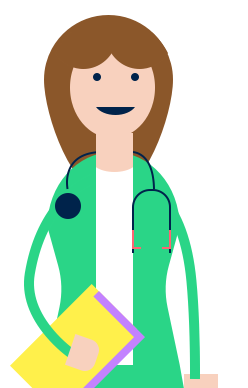Leukaemia causes the uncontrolled production of abnormal white blood cells. Identify the signs of leukaemia and learn about leukaemia treatment.
What is Leukaemia?
Leukaemia starts in the bone marrow, where blood cells are made. It causes uncontrolled production of abnormal white blood cells, called leukaemia cells. These cells do not function normally, and, over time, they crowd out normal blood cells and usually lead to anaemia, bleeding and infections.
Leukaemia Risk Factors
- Prior exposure to chemotherapy and radiation therapy due to treatment for other cancers.
- Genetic abnormalities such as Down syndrome.
- Exposure to intense radiation and certain chemicals.
- Exposure to viruses such as the human T-cell leukaemia virus.
People who think they may be at risk should discuss this with their doctor.
Types of Leukemia
Leukaemia is usually classified as either chronic (conditions get worse slowly) or acute (conditions get worse quickly). This can be further sub-grouped into the following:
- Acute myelogenous Leukemia (AML) — the most common type of leukaemia
- Acute lymphocytic Leukemia (ALL) — the most common type of leukaemia in young children
- Chronic lymphocytic Leukemia (CLL) — a common adult leukaemia
- Chronic myelogenous Leukemia (CML) — mainly affects adults
The different types of leukaemia will, in turn, determine the symptoms and ultimately the treatment prescribed.
Signs of Leukemia
Patients with chronic leukaemia may not experience any symptoms, and their condition is usually detected from routine blood tests. However, for patients with acute leukaemia and as the conditions worsen for chronic leukaemia patients, symptoms may include:
- Fever or chills
- Persistent fatigue or weakness
- Loss of appetite or weight
- Swollen lymph nodes, enlarged liver or spleen
- Easy bleeding, or bruising, or tiny red spots in the skin (petechiae)
- Shortness of breath or excessive sweating, especially at night
- Bone pain or tenderness
- Frequent infections
Often, these symptoms can also be caused by problems other than cancer; only a doctor can tell for sure. For an accurate diagnosis, a doctor should be consulted if the symptoms above occur.
Diagnosis of Leukemia
If you experience any of the symptoms mentioned, the doctor will need to run some tests to determine what is causing the problems. Your doctor may ask about your personal and family medical history.
You may have one or more of the following tests:
- Physical exam: your doctor will check for swollen lymph nodes, spleen or liver.
- Blood tests: your doctor will complete a blood count to check the number of white blood cells, red blood cells, and platelets. Leukaemia causes a very high level of white blood cells and may also lead to low levels of platelets and haemoglobin, which is found inside red blood cells.
- Biopsy: a biopsy is the removal of tissue or fluid to look for cancer cells. Your doctor may suggest either a bone marrow aspiration (removing samples of the bone marrow fluid) or a bone marrow biopsy (removing a small piece of tissue or bone). After the samples are taken, the tissue will be checked for leukaemia cells.
If leukaemia cells are found, other tests will be conducted to determine what type of leukaemia you have or detect signs of other problems.
Leukaemia Treatment
There are different treatments available, depending on the type of leukaemia. Other factors include your age, your overall health and your own preferences. The types of treatment that may be prescribed are as follows:
Chemotherapy
Chemotherapy is the use of drugs to help kill leukaemia cells. Depending on the type of leukaemia, you may receive a single drug or a combination of two or more drugs. The drugs are injected into a vein or the cerebrospinal fluid or by mouth. Once the drugs enter the system, they will spread throughout the body.
Chemotherapy is usually given in cycles. Each treatment cycle is followed by a rest period. You may have your treatment in a clinic at the doctor’s office. Some patients may need to stay in the hospital for treatment.
Targeted Therapy
Targeted therapy uses drugs to block the growth of leukaemia cells through the interference of specific targeted molecules. The drugs can stop cancer cells from progressing, kill cancer cells and even stimulate the immune system to recognise and destroy cancer cells while sparing normal cells.
Biological Therapy
Biological therapy is the use of substances that bolster one’s immune response to leukaemia. This can be administered through the vein or injected under the skin into a muscle. The drugs can either slow the growth of the leukaemia cells or help the immune system destroy the cells.
Radiation Therapy
Radiation therapy is a cancer treatment that uses high energy X-rays or other types of radiation to kill leukaemia cells or keep them from growing. In such cases, radiation will be targeted at the spleen, the brain or other parts of the body where leukaemia cells have collected.
Stem Cell Transplant
A stem cell transplant replaces the abnormal bone marrow with stem cells or marrow free of leukaemia from a compatible donor.
Before the stem cell transplant, you will receive either chemotherapy or radiation therapy in high dosages. In some cases, even both may be prescribed. This will destroy all your leukaemia cells and normal blood cells in your bone marrow. After which, you will receive the healthy stem cells through a large vein.
The healthy stem cells may come from you or from someone who donates their stem cells to you:
- From yourself: an autologous stem cell transplant uses your own stem cells. Your stem cells are removed before you receive high-dose chemotherapy or radiation therapy. The cells may then be removed to treat any leukaemia cells present. Your stem cells will be frozen and stored. After you receive treatment to remove leukaemia cells from your marrow, your stem cells will then be thawed and used.
- From a family member or other donor: an allogeneic stem cell transplant uses healthy stem cells from a donor. Your brother, sister, or parent may be the donor. Sometimes, the stem cells come from a donor who isn't related. Doctors use blood tests to discover how closely a donor's cells match your cells.
- From your identical twin: if you have an identical twin, a syngeneic stem cell transplant uses stem cells from your healthy twin.
After the transplant, the new blood cells will then develop from the transplanted stem cells and replace those destroyed by the treatment. You may have to stay in the hospital for several weeks or months to recuperate. The time needed differs for individuals.
Leukemia Prevention
There is no known way to prevent most types of leukaemia. Most people with leukaemia do not have known risk factors. However, some types of leukaemia may be prevented by avoiding:
- High doses of radiation
- Exposure to the chemical benzene
- Smoking and other tobacco use
Download the HealthHub app on Google Play or Apple Store to access more health and wellness advice at your fingertips.

HealthHub AI















